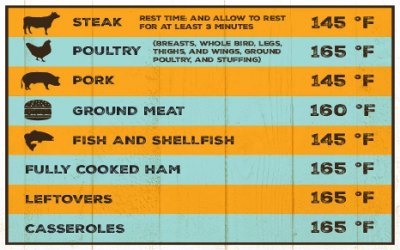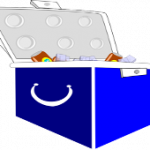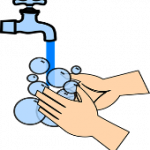Written by UConn Dietetics Student Sarah Anderson
As the days get longer and the warmer weather is approaching, grilling and outdoor dining is right around the corner! Food safety is especially important when considering the warmer temperatures which provide an ideal environment for bacteria to grow. It is key to keep food out of the “Danger Zone” (40°F to 140°F) where foodborne bacteria thrive1. Here are some helpful tips to prevent foodborne illnesses this summer!
Keep Cold Foods Cold
 Foods that are perishable—proteins like uncooked meat, poultry, and fish— as well as prepared foods like coleslaw and potato salad should be refrigerated at 40°F or below to prevent the growth of bacteria. When enjoying these foods outside, the Center for Disease Control and Prevention (CDC) states that perishable foods need to be refrigerated within 1 hour when it is 90°F or warmer1. If using coolers to store foods, keep them closed as much as possible to keep the contents cold. It is recommended to use a separate cooler for drinks as it is the most frequently opened container.
Foods that are perishable—proteins like uncooked meat, poultry, and fish— as well as prepared foods like coleslaw and potato salad should be refrigerated at 40°F or below to prevent the growth of bacteria. When enjoying these foods outside, the Center for Disease Control and Prevention (CDC) states that perishable foods need to be refrigerated within 1 hour when it is 90°F or warmer1. If using coolers to store foods, keep them closed as much as possible to keep the contents cold. It is recommended to use a separate cooler for drinks as it is the most frequently opened container.
Cook Foods to the Proper Temperature
 Cooking foods thoroughly to the safe cooking temperature is crucial to preventing the growth of bacteria. It is important to have a food thermometer to ensure that the temperature is safe. Relying on the color and texture of the food is not reliable. To the left is a chart from the U.S. Food and Drug Administration (FDA) that lists the safe food temperatures based on food type2. Like cold foods, hot foods should be refrigerated within 1 hour when it is 90°F or warmer.
Cooking foods thoroughly to the safe cooking temperature is crucial to preventing the growth of bacteria. It is important to have a food thermometer to ensure that the temperature is safe. Relying on the color and texture of the food is not reliable. To the left is a chart from the U.S. Food and Drug Administration (FDA) that lists the safe food temperatures based on food type2. Like cold foods, hot foods should be refrigerated within 1 hour when it is 90°F or warmer.
Prevent Cross-Contamination by Separating Foods
Raw meats, poultry, and seafood should be separated from ready-to-eat foods and raw fruits and vegetables. This prevents the juices from the raw meat coming into contact with these other raw foods. When  cutting or preparing raw meats, use a separate cutting board from the one used for fruits and vegetables. After marinating raw meats, discard the marinade. Finally, do not use the same plate or surface to place cooked meats that once held raw meats without washing with hot soapy warm first2.
cutting or preparing raw meats, use a separate cutting board from the one used for fruits and vegetables. After marinating raw meats, discard the marinade. Finally, do not use the same plate or surface to place cooked meats that once held raw meats without washing with hot soapy warm first2.
Transport Foods Safely
Whether you are bringing foods home from the store or traveling to an event, safely storing foods during transportation is vital.  Insulated handled bags sold at many stores are economical and convenient containers for this! Ready-to-eat foods (including fruits and vegetables that will be eaten raw) and raw meat, poultry, and seafood need to be stored separately to prevent cross-contamination. Additionally, use ice packs to keep cold foods cold to prevent the growth of bacteria.
Insulated handled bags sold at many stores are economical and convenient containers for this! Ready-to-eat foods (including fruits and vegetables that will be eaten raw) and raw meat, poultry, and seafood need to be stored separately to prevent cross-contamination. Additionally, use ice packs to keep cold foods cold to prevent the growth of bacteria.
Keep it Clean
Handwashing is key to preventing the spread of bacteria. Using soap and warm water, wash your hands for at least 20 seconds  before and after handling food like raw meat or when changing tasks; after using the bathroom; after handling pet; after attending to a sick person; after blowing your nose; coughing or sneezing; and after changing a diaper2. Wash all cutting boards and utensils as well as surfaces like countertops and tables with hot, soapy water in between preparing different food items and when they are visibly dirty. Rinse fruits and vegetables under running water even if you do not intend to eat or use the skins during cooking.
before and after handling food like raw meat or when changing tasks; after using the bathroom; after handling pet; after attending to a sick person; after blowing your nose; coughing or sneezing; and after changing a diaper2. Wash all cutting boards and utensils as well as surfaces like countertops and tables with hot, soapy water in between preparing different food items and when they are visibly dirty. Rinse fruits and vegetables under running water even if you do not intend to eat or use the skins during cooking.
Now you are ready to enjoy a safe and healthy summer of cooking!
References:
- CDC and food Safety: Tips to keep food safe this summer. (2019, June 07). Retrieved April 27, 2021, from https://www.cdc.gov/foodsafety/newsletter/food-safe-summer-5-22.html
- Center for Food Safety and Applied Nutrition. (n.d.). Handling food safely while eating outdoors. Retrieved April 27, 2021, from https://www.fda.gov/food/buy-store-serve-safe-food/handling-food-safely-while-eating-outdoors
This material was funded by USDA’s Supplemental Nutrition Assistance Program (SNAP).
This institution is an equal opportunity provider.